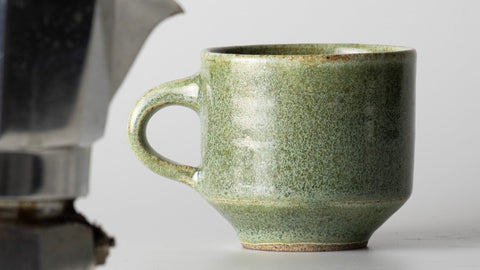When I enter the studio with my students, the question always comes up:
“Why did you choose stoneware instead of earthenware?”
It’s not a trivial curiosity. Behind that question lies an entire world—one made of chemistry, history, aesthetics, and material culture. Every decision in ceramics tells a story: the story of kilns, minerals, and glazes, but also of daily habits, traditions, and how societies have evolved around this humble material.
For me, talking about earthenware and stoneware means exploring two souls of the same substance: clay.
They share the same origin, but they react to fire in radically different ways, taking on opposite characters and leading to different uses. Understanding these differences also helps explain why stoneware is the ideal material for Erra Ceramica's tableware.
What is Earthenware? What is Stoneware?
Earthenware is a low-fire ceramic body, fired between 980°C and 1100°C (1796–2012°F). It never reaches full vitrification, which makes it porous, with water absorption rates between 10–15%.
To make it waterproof, it must be coated with low-fire glazes, which are often delicate and less durable over time. Once fired, earthenware appears light in weight and pale in color—white or slightly pinkish.
Stoneware, on the other hand, requires kilns that reach 1200–1300°C (2192–2372°F). At these high temperatures, complete vitrification occurs: the quartz and feldspar particles melt, sealing the pores and making the ceramic body naturally impermeable (with water absorption often below 2%, sometimes as low as 0.5%).
The result is a dense, strong material with a flexural strength of 40–60 MPa, compared to the 15–25 MPa of earthenware.
That’s the key distinction:
Earthenware remains soft and porous. Stoneware becomes almost a man-made stone.
A Brief History of Earthenware
Earthenware has ancient roots. The Etruscans were already firing porous clays coated in slips and metallic oxides. But the real revolution in Italy came with tin-glazed earthenware, introduced by Islamic artisans between the 9th and 10th centuries. It spread first in Spain, then to Italy via Mallorca, hence the name “maiolica”.
This technique added tin oxide to a lead-based glaze, transforming it from transparent to opaque white. For the first time, potters could mask the reddish body of earthenware with a brilliant white surface, perfect for vibrant decoration using metallic oxides.
Thanks to this innovation, Italian potters gave birth to the masterpieces of Faenza, Deruta, Montelupo, and Vietri, tableware and painted plates that brought accessible yet refined art into everyday homes.
In a way, tin glazing made earthenware a serious rival to Chinese porcelain, which had long captivated European courts with its naturally white, glassy finish. Earthenware became the material of the Renaissance courts, bourgeois households, and decorated wares that narrated both sacred and profane stories. It was ideal for Italy, less energy-intensive, requiring lower kiln temperatures, and offering brilliant surfaces for colored glazes to shine.
Even today, earthenware is still used where porosity is an advantage. Think of the large Tuscan terracotta pots used in Medici gardens to house trees and monumental plants. Their ability to "breathe" makes them perfect for outdoor use. Despite the risk of frost causing microfractures, their thickness and traditional construction make them incredibly durable, many are centuries old and still standing.
A Story of Stoneware
Stoneware tells a different story. It originated in China, where as early as the Tang dynasty (7th–10th centuries), kilns were reaching extremely high temperatures. This led to the development of the iconic celadon glazes, with their translucent greens, and the highly refined, minimalist Song ceramics.
The invention of high-temperature firing changed everything: ceramic wares no longer needed glazes for functionality, they became waterproof by nature. To see some beautiful examples, I recommend a visit to the International Museum of Ceramics in Faenza, which hosts an extraordinary collection.
From China and Japan, stoneware made its way to northern Europe. In 16th-century Germany, potters developed salt-glazed beer steins by throwing sodium chloride into the kiln during firing. This created a natural, glassy coating.
To this day, these wares are known for their hardness and impermeability.

Medieval salt-glazed stoneware jug, probably early Siegburg c.1375-1450. Courtesly Paul Bohanna Antiques.
In Italy stoneware remained on the fringes for centuries. Our culture prioritized the vibrant colors of maiolica, while stoneware seemed more austere and subdued.
Only in the 20th century, with the rise of porcelain stoneware tiles for architecture, did the term become common.
Yet even now, when I work in studios in Belgium, the Netherlands, or Denmark, I see how stoneware is the default choice for durable, everyday tableware.
How Firing Temperature Affects the Results
Fire is the real judge.
-
Earthenware, fired at low temperatures, remains fragile and porous. It requires glazes that melt around 1000°C, which allow for vivid colors, but are more susceptible to wear and scratching.
-
Stoneware, fired above 1200°C, becomes dense and durable. High-fire glazes mature more consistently, creating surfaces that are food-safe and long-lasting.
| Property | Earthenware | Stoneware |
|---|---|---|
| Water Absorption | 10–15% | <2% (often <0.5%) |
| Flexural Strength | 15–25 MPa | 40–60 MPa |
| Freeze Resistance | Poor | Excellent |
| Thermal Expansion | Less stable | More stable (ideal for flame or oven use) |
When to Choose One Over the Other
This isn’t about declaring a winner.
Earthenware and stoneware serve different purposes.
Earthenware
-
Ideal for decorative objects and artistic maiolica.
-
Best for planters and garden pots, where breathability is an asset.
-
Requires less energy to fire, making it more economical.
-
Produces vivid, bright glazes that are hard to replicate at high temperatures.
Stoneware
-
Perfect for everyday tableware that needs to withstand frequent use.
-
Highly resistant to thermal shock, impact, and dishwasher cycles.
-
Food-safe, even without glaze (when fully vitrified).
-
Offers an enormous range of textures and surfaces, from soft satin to glossy glass-like finishes.
-
Requires more powerful kilns and higher energy consumption—but the durability is unmatched.
Why I Chose Stoneware for Erra Ceramica
The answer to “Why stoneware?” isn’t just technical. Of course, there’s safety, durability, and glaze variety. But there’s something more personal, too: Stoneware doesn’t need protection, it is born strong, forged in fire.
I wanted to create tableware that endures over time: not just beautiful, but reliable. When someone sets one of my cups or plates on the table, I want them to feel that silent strength—that reassuring density and permanence.
Yes, earthenware is part of our tradition, and it will continue to have its place. But for me, stoneware is the perfect balance between technique and poetry: a material completed by fire that becomes a lifelong companion.
After all, there’s a reason why 16th-century German stoneware mugs are still clinking today after centuries of use.
Cheers to that!
References & Further Reading
Rhodes, D. Clay and Glazes for the Potter. Chilton Book Company
Hamer, F. & Hamer, J. The Potter’s Dictionary of Materials and Techniques. Bloomsbury
Cardew, M. Pioneer Pottery. Longman
ASTM Standards on Ceramic Whitewares (mechanical strength and water absorption data)
Digitalfire Ceramic Materials Database

